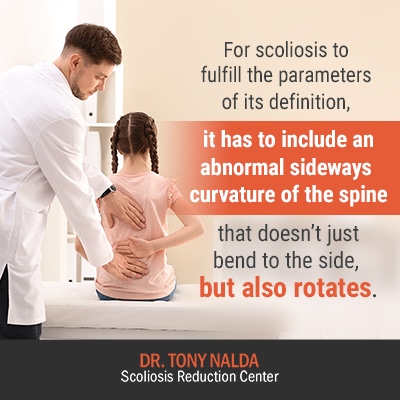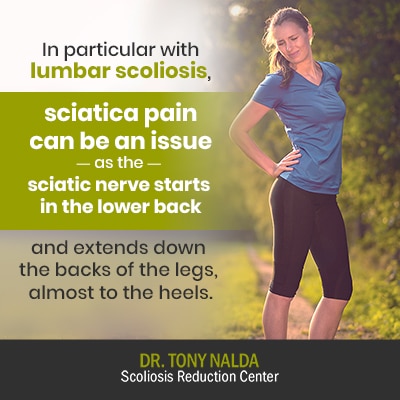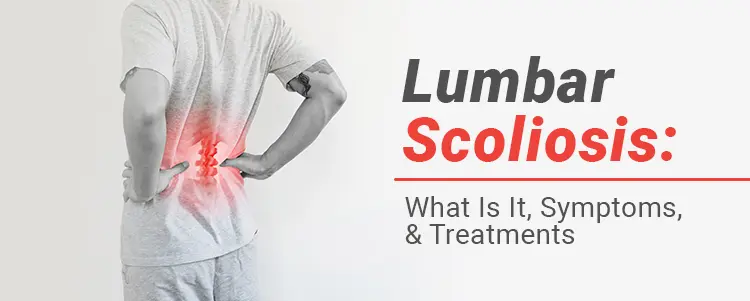When it comes to scoliosis, every case is unique. Not only are there different types of scoliosis that can develop, it can develop anywhere along the spine and range greatly in severity and experienced symptoms. Keep reading to learn more about lumbar scoliosis and why there is such a wide range of scoliosis types, severity levels, and symptoms.
There are three main sections to the spine: cervical, thoracic, and lumbar. When scoliosis develops along the lumbar spine, this involves the lower back and is diagnosed as lumbar scoliosis; symptoms and treatment will vary based on a number of patient/condition characteristics.
Before we start exploring the specifics of lumbar scoliosis, including potential symptoms and effective treatment options, let’s first touch on some general spinal anatomy and scoliosis characteristics.
Anatomy of the Spine
As mentioned, there are three main sections of the spine, and each section has its own healthy and natural curvature.
The cervical spine refers to the neck and has a curvature with a gentle inward curve; think of a reverse ‘C’ shape. The thoracic spine refers to the middle and upper back and features an outward curvature, forming a regular ‘C’ shape. The lumbar spine refers to the lower back, and like the cervical spine, features a gentle backward curve in a reverse ‘C’ shape.
Curvatures are referred to as either lordotic or kyphotic. ‘Lordotic’ or ‘lordosis’ refers to curvatures that bend inward, towards the body’s center; these are the reverse ‘C’-shaped curves of the cervical and lumbar spine. ‘Kyphotic’ or ‘kyphosis’ refers to curvatures that bend outwards, away from the body’s center, such as the thoracic spine’s healthy curvature.
The spine features these natural and healthy curves because they make it stronger, more flexible, allow us to stand upright and practice good posture, and help to distribute mechanical stress that occurs through movement.
The spine is made up of rectangular-shaped bones called vertebrae stacked on top of one another, and these bones are separated by intervertebral discs that provide cushioning, facilitate movement, and act as the spine’s shock absorbers.
When scoliosis comes into play, the vertebrae of the spine become misaligned, meaning there is a shift that occurs as the abnormal sideways curvature of the spine, with rotation, develops.
To understand scoliosis in general, it’s important to understand how and why the spine is naturally curved, and the roles that these curvatures play. This is important because scoliosis involves a loss of one or more of these healthy curves, and when that happens, the biomechanics of the entire spine is disrupted and can lead to a host of symptoms felt throughout the body, and not just in the back.
Now that we have looked at some basic spinal anatomy for a better understanding of the spine’s structure, particularly the roles of its healthy curvatures, let’s take a look at how scoliosis is classified once it’s diagnosed.
How Scoliosis is Classified
When a person is diagnosed with scoliosis, it’s further classified based on a number of important patient and condition characteristics; these factors will vary from one patient to the next, which is why treatment needs to be fully customized.

For scoliosis to fulfill the parameters of its definition, it has to include an abnormal sideways curvature of the spine that doesn’t just bend to the side, but also rotates.
In addition, the spine’s sideways curvature has to be of a certain size, and this is determined by the patient’s Cobb angle.
Cobb Angle
Cobb angle is a measurement taken during X-ray that tells us how far out of alignment a patient’s spine is. Cobb angle also places a condition on its severity scale of mild, moderate, severe, or very severe:
- Mild scoliosis: Cobb angle measurement of between 10 and 25 degrees
- Moderate scoliosis: Cobb angle measurement of between 25 and 40 degrees
- Severe scoliosis: Cobb angle measurement of 40+ degrees
- Very-severe scoliosis: Cobb angle measurement of 80+ degrees
The higher the Cobb angle, the more severe a condition is considered. In addition to condition severity, scoliosis is also classified based on patient age, condition type, and curvature location.
Patient Age
Patient age is important, not only for the obvious reason of determining a patient’s general health and fitness level, but also because scoliosis is progressive, meaning it’s in its nature to worsen over time, especially if left untreated.
Age plays a big role in progression because growth is its number-one trigger. For children and adolescents who have not yet hit their first big growth spurt, we know they are at risk for rapid-phase progression once they enter into the stage of puberty.
While there are tests and ways to determine a patient’s ‘likeliest’ rate of progression, these are only predictive models; there is no definitive means by which we can determine exactly how much a patient’s scoliosis is going to progress, or how fast, or slowly, their curvature will increase over time.
While progression tends to slow once skeletal maturity has been reached and the big trigger of growth is removed, once natural degenerative changes associated with aging come into play, that progressive rate can increase; this is especially true if there are additional spinal conditions, such as osteoarthritis or osteoporosis, also compromising the spine’s overall health and function.
Condition Type
It’s important to understand that there is not just one type of scoliosis: there are several. The vast majority of scoliosis cases are idiopathic, meaning they are not associated with any single-known cause.
In fact, 80 percent of known scoliosis cases are idiopathic, and the most prevalent form is adolescent idiopathic scoliosis (AIS) diagnosed in adolescents between the ages of 10 and 18.
The remaining 20 percent are types associated with known causes such as congenital, neuromuscular, degenerative, or traumatic.
Condition type is an important classification factor because often the cause will guide the treatment approach, as different forms have different characteristics and treatment needs.
Curvature Location
As mentioned, there are three main spinal sections, and while scoliosis most commonly develops in the thoracic spine, it can develop anywhere along the spine.
Knowing where the most-tilted vertebrae of the curvature are located helps classify the condition based on which section of the spine is most in need of treatment.
Not only does knowing the location of the curvature tell us where we need to focus our treatment efforts, especially in terms of focused chiropractic adjustments, it also helps us predict the type of symptoms a patient is likely to experience, as well as likely progressive rates; this is because certain curvature patterns tend to progress more than others.
If the most-tilted vertebrae of a curvature are located in the lumbar spine, this is lumbar scoliosis, meaning a patient has a scoliotic curve in their lower back.
Lower spine scoliosis, also known as lumbar spine scoliosis, is a condition in which the lower part of the spine, specifically the lumbar region, is affected by an abnormal curvature of the spine. This condition is also referred to as scoliosis of the lumbar spine, or simply scoliosis lumbar spine. The lumbar region is located in the lower back and is comprised of five vertebrae. Scoliosis in the lumbar spine can range from mild to severe, and symptoms can include back pain, changes in gait and balance, and postural changes such as uneven hips and shoulders.
Rotoscoliosis of the lumbar spine is a specific type of lumbar scoliosis in which there is both a sideways curvature and rotation of the vertebrae in the lower back. This type of scoliosis can be more complex to treat and may require a customized treatment plan that takes into account the unique characteristics of the patient’s condition.
It’s important to note that lumbar scoliosis can occur in conjunction with scoliosis in other parts of the spine. For example, a patient may have scoliosis in the thoracic spine (upper back) as well as in the lumbar spine. The location of the spinal region affected by scoliosis will impact the treatment approach and the potential for symptom relief.
Acute scoliosis is a term used to describe a sudden onset of scoliosis that develops over a period of days or weeks. This type of scoliosis is rare and can be caused by a number of factors, including infection, trauma, or degenerative conditions. Acute scoliosis of the lumbar spine can cause severe back pain and may require immediate medical attention.
What does lumbar scoliosis look like?
The appearance of lumbar scoliosis will depend on the severity of the curvature and the specific characteristics of the patient’s condition. In general, lumbar scoliosis may be characterized by a noticeable asymmetry in the lower back, uneven shoulders and hips, and a twisting or rotational component to the curvature. A medical professional can provide a diagnosis and offer further insight into what lumbar scoliosis may look like for an individual patient.
As different condition types, severity levels, and curvature location factors into what, if any, symptoms a patient is likely to experience, let’s discuss what symptoms of lumbar scoliosis can include.
Lumbar Scoliosis Symptoms
As mentioned, every condition is unique, and now that I have touched on the different factors that go into classifying scoliosis, you can see why.
There are so many characteristics that go into determining how a person will experience life with their condition in terms of progression and symptoms; these characteristics all factor into the design of my customized treatment plans.
The thing to remember is that with scoliosis, even though a curvature might develop in one location initially, the spine can respond to the presence of one abnormal curvature by adding another counteractive curvature. For example, while lumbar scoliosis involves the lower back, it can also impact the upper back if a counteractive curve develops.
Basically, a loss of one of the spine’s healthy curves impacts the others as the healthy curvatures are connected.
Symptoms of lumbar scoliosis can include, but are not limited to:
- Uneven shoulders and hips
- A noticeable asymmetry in the lower back
- Back and/or leg pain
- Changes in gait and balance
As mentioned, condition severity plays a big role in whether or not a patient’s condition will produce noticeable symptoms such as postural changes and pain. In mild forms of lumbar scoliosis, it’s not uncommon for people to progress with the condition into maturity, without a diagnosis or treatment, as they are unaware of the condition.
Lumbar scoliosis is a condition characterized by abnormal curvature of the lower spine, with varying degrees of scoliosis curvature types. When diagnosed with moderate scoliosis, typically at around 10 degrees, understanding the symptoms and available treatments becomes essential for effective management and relief.
Lumbar scoliosis, characterized by levoconvex curvature, often manifests with symptoms such as levoconvex lumbar lordosis, impacting spinal alignment and potentially affecting daily activities, including challenges associated with sleep for those with levoscoliosis.
It can seem difficult to understand how a person can live with a progressive spinal condition unaware, and pain is a big part of that, so let’s explore the topic of pain and lumbar scoliosis a little more thoroughly.
Lumbar Scoliosis and Pain
All of the factors that go into classifying a condition also play a role in how painful a condition is likely to be.
A very important pain-related factor in all forms of scoliosis is patient age. In patients who are young and still growing, scoliosis is not typically painful; this is because growing spines are constantly being lengthened, and this counteracts the compressive force of an abnormal spinal curvature.
In adults who have reached skeletal maturity, their spines and surrounding muscles, vessels, and nerves are susceptible to compression, which is the source of pain.

In particular with lumbar scoliosis, sciatica pain can be an issue as the sciatic nerve starts in the lower back and extends down the backs of the legs, almost to the heels.
When the lumbar spine is bent and twisted, it can put pressure on the spine and its surroundings, and if the sciatic nerve is compressed, it can cause pain felt not only in the lower back, but also as radiating pain down the backs of the legs and into the feet.
Nerve-related back pain is often described as one of the worst types of back pain and can range from mild to debilitating.
In general, however, lumbar scoliosis is not typically painful for children and adolescents, but can be for adults.
So if you suspect you have lumbar scoliosis, or are experiencing worsening symptoms related to your lumbar scoliosis, what should you do next?
Lumbar Scoliosis and Treatment
The most important scoliosis-related decision patients make is how to move forward with treatment following a diagnosis.
Whether you are experiencing noticeable symptoms or not, as a progressive condition, lumbar scoliosis is likely to get worse at some point, especially if left untreated.
Proactive treatment is always a good choice as it has the potential to positively impact the condition so progression can be monitored, managed, and the abnormal spinal curvature can be reduced.
Here at the Scoliosis Reduction Center®, I offer patients a functional chiropractic-centered approach featuring the integration of multiple treatment disciplines: chiropractic care, in-office therapy, custom-prescribed home exercises, and specialized corrective bracing.
As lumbar scoliosis is structural, it has to be impacted on a structural level, first and foremost. We also work towards improving core strength so the muscles that closely surround the spine can provide it with better support and stabilization.
By combining different treatment disciplines, patients of the Center can benefit from multiple forms of treatment, and this also allows me to fully customize each and every treatment plan to address specific patient and condition characteristics.
Lumbar scoliosis is a specific form of scoliosis that affects the lumbar region of the spine. It can vary in severity, from mild scoliosis with subtle symptoms to more pronounced forms like levoscoliosis, where the spine curves to the left. Understanding how scoliosis is classified helps healthcare professionals determine the most appropriate treatments.
Treatments for lumbar scoliosis can range from conservative approaches like physical therapy to more invasive options like spinal surgery. Additionally, in some cases, you may come across terms like “rotoscoliosis,” which describe a twisting or rotational element within the scoliotic curve, adding complexity to the condition’s diagnosis and management.
Conclusion
Scoliosis is a progressive spinal condition that involves having an abnormally-curved spine. Scoliotic curves bend to the side and rotate and can develop in any one of the spine’s three main sections: cervical, thoracic, or lumbar.
If you have been diagnosed with lumbar scoliosis, this means you have scoliosis in your lower back, and while everyone has their own unique experience of life with the condition, common symptoms can include back and/or leg pain (more so in adults) and postural changes such as uneven hips and shoulders.
When it comes to treatment, being proactive is important. There is no harm to starting treatment while a curvature is small and potentially making it smaller, but there is harm in allowing a curvature to progress unimpeded.
Here at the Scoliosis Reduction Center®, I approach each patient as a blank canvas. Through a comprehensive process of diagnosing and assessing every condition, I design a fully-customized scoliosis treatment plan that prioritizes a curvature reduction while preserving the spine’s overall health and function.





